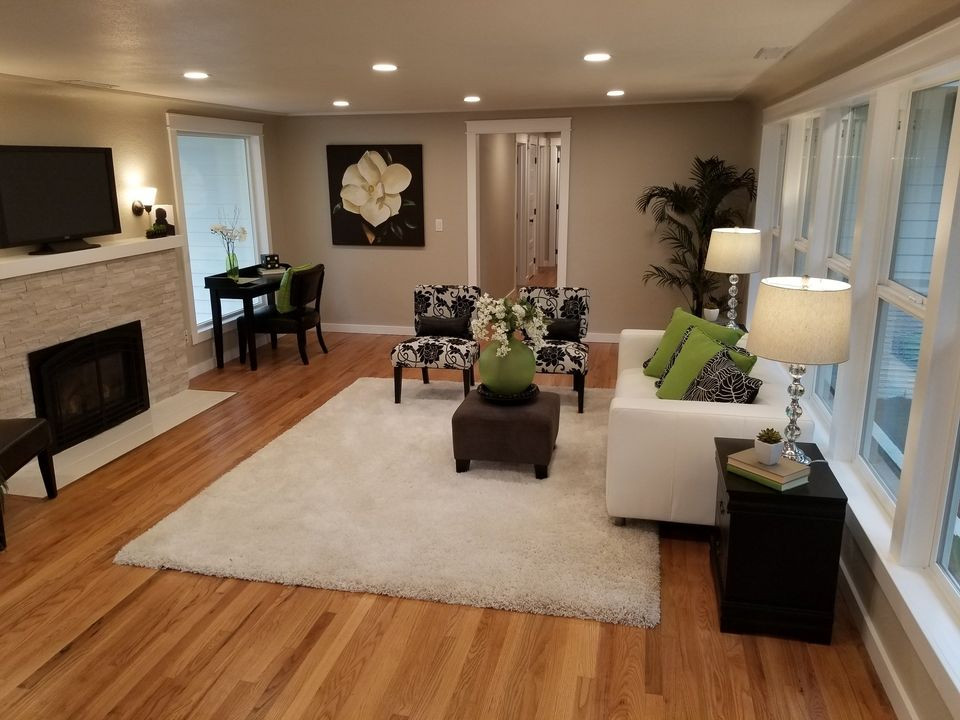Selecting a flooring for any room

Selecting the proper style of flooring for a room:
Knowing the difference between a wet room and dry room will allow you to place the proper flooring in each room. However, to say that a room is a wet room strictly due to the presence of plumbing in that room would be an oversimplification.
What is a wet room? A wet room is a room that typically has no enclosure separating the shower or tub from the rest of the bathroom. A wet room is any room that has the potential for sustained moisture. This means the steam from your shower, splashing for the sinks while washing hands or dishes, the water that drips off your body as you dry after a bath. All of these sources are not immediately cleaned up and the flooring should be able to repel the moisture and not absorb it.
Examples of wet room flooring: Wet rooms should have a water-resistant flooring that allows for simply and quick cleanup, while a dry room should have carpet of a flooring comfortable to walk barefoot on. Kitchens, Dining rooms, bathrooms, laundry rooms, entry ways and halls should all have a flooring that is durable for the heavy traffic use.
Wet Room:
· Tiles – Natural stone and porcelain tiles are becoming the most popular choice in wet rooms as they give a beautiful, contemporary, and hardwearing finish.
· Vinyl – Cost-effective and available in a wide range of colors and styles, vinyl is a common choice for wet room flooring outside of the shower area.
Vinyl planks or tile work best in these areas as you can go from one room to another without needing a transition strip between rooms. If you have kids, pets, or lots of company, hardwood or vinyl will provide a longer lasting flooring that will need less maintenance, and is easier cleaning.
· Linoleum - comprised of natural raw materials such as linseed oil, flax, wood flour, cork dust, calcium carbonate, and jute. This popular flooring solution typically comes in one of three methods.
1. Linoleum sheets, Commonly glued down with a water-based adhesive, sheet linoleum is spread about and cut to fit the layout of the room or space.
2. Linoleum tiles, Much like sheet linoleum, these tiles also implement a glue-down method using a water-based type adhesive. With slightly beveled edges, the pieces fit tightly together like a puzzle, almost looking completely seamless.
3. Click-together tiles, Differing from sheet linoleum and linoleum tiles, this click-together method can be installed as a floating floor, meaning that the tiles can be installed without the need glue or messy type adhesives.
Linoleum flooring traditionally comes in a 12-foot-wide roll and will need transition strips between rooms, or in the middle of a room if it is wider than 12 foot.
Dry Room: is a where moisture should be cleaned up immediately after a spill, and traditionally doesn’t have a moisture source, and liquids are carried into the rooms. I also like to think that these rooms are the ones that I would like to be barefoot in. This is reason that a lot of carpeted living rooms have a tile of vinyl entry before the carpet starts.
The use of the room will also have an impact on the flooring you choose.
Office Flooring: While a bedroom has carpet, an office should have flooring that is durable enough to withstand a chair rolling on it. Carpet will make the chair harder to roll. If the office is doubled as a guest room a throw rug will allow the guests to not set onto a cold floor while still being able to use it to the potential, you need it to reach.
Examples of office flooring: wood, engineered flooring materials, vinyl, tile, and carpet.
If you have questions about what type of office flooring would work best for your business or home office, please reach out to us at bettertogetherconstruction1@gmail.com
Entry Room Flooring: Rooms that are most often overlooked are the entry rooms, the laundry room from the garage or back door that gets the wet shoes prints that get left to dry, or the entry from the front door where shoes are often taken off.
Kitchens, Dining rooms, bathrooms, laundry rooms, entry ways and halls should all have a flooring that is durable for the heavy traffic use.
Placing the proper flooring in your home and office will help you to maintain the house much longer. We can help you make it an easy choice of which type of flooring would be best for your project.
Bedrooms, dens, and other comfort rooms: should receive carpet.
Carpet comes in 12-foot rolls but can be seemed to fill any space possible without it being noticeable.
Living rooms are the tricky part, some people love carpet in the living room, others like the durability of a vinyl or hardwood floor. This comes down to your personal preference.
